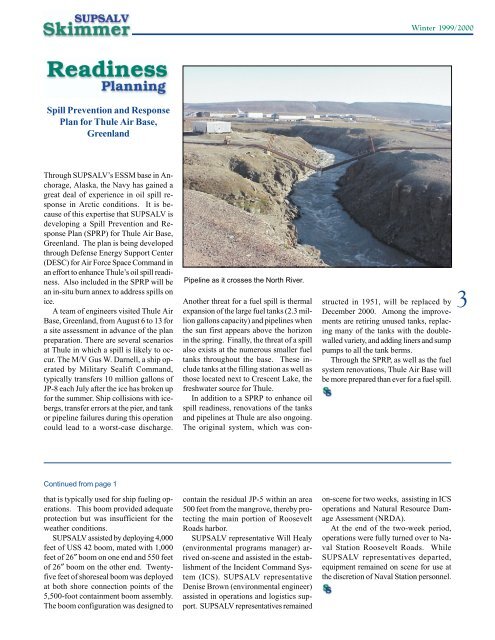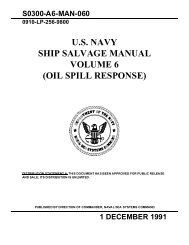Gallon JP-5 Spill at Naval Station Roosevelt Roads - Supervisor of ...
Gallon JP-5 Spill at Naval Station Roosevelt Roads - Supervisor of ...
Gallon JP-5 Spill at Naval Station Roosevelt Roads - Supervisor of ...
Create successful ePaper yourself
Turn your PDF publications into a flip-book with our unique Google optimized e-Paper software.
Winter 1999/2000<strong>Spill</strong> Prevention and ResponsePlan for Thule Air Base,GreenlandThrough SUPSALV’s ESSM base in Anchorage,Alaska, the Navy has gained agre<strong>at</strong> deal <strong>of</strong> experience in oil spill responsein Arctic conditions. It is because<strong>of</strong> this expertise th<strong>at</strong> SUPSALV isdeveloping a <strong>Spill</strong> Prevention and ResponsePlan (SPRP) for Thule Air Base,Greenland. The plan is being developedthrough Defense Energy Support Center(DESC) for Air Force Space Command inan effort to enhance Thule’s oil spill readiness.Also included in the SPRP will bean in-situ burn annex to address spills onice.A team <strong>of</strong> engineers visited Thule AirBase, Greenland, from August 6 to 13 fora site assessment in advance <strong>of</strong> the planprepar<strong>at</strong>ion. There are several scenarios<strong>at</strong> Thule in which a spill is likely to occur.The M/V Gus W. Darnell, a ship oper<strong>at</strong>edby Military Sealift Command,typically transfers 10 million gallons <strong>of</strong><strong>JP</strong>-8 each July after the ice has broken upfor the summer. Ship collisions with icebergs,transfer errors <strong>at</strong> the pier, and tankor pipeline failures during this oper<strong>at</strong>ioncould lead to a worst-case discharge.Pipeline as it crosses the North River.Another thre<strong>at</strong> for a fuel spill is thermalexpansion <strong>of</strong> the large fuel tanks (2.3 milliongallons capacity) and pipelines whenthe sun first appears above the horizonin the spring. Finally, the thre<strong>at</strong> <strong>of</strong> a spillalso exists <strong>at</strong> the numerous smaller fueltanks throughout the base. These includetanks <strong>at</strong> the filling st<strong>at</strong>ion as well asthose loc<strong>at</strong>ed next to Crescent Lake, thefreshw<strong>at</strong>er source for Thule.In addition to a SPRP to enhance oilspill readiness, renov<strong>at</strong>ions <strong>of</strong> the tanksand pipelines <strong>at</strong> Thule are also ongoing.The original system, which was constructedin 1951, will be replaced byDecember 2000. Among the improvementsare retiring unused tanks, replacingmany <strong>of</strong> the tanks with the doublewalledvariety, and adding liners and sumppumps to all the tank berms.Through the SPRP, as well as the fuelsystem renov<strong>at</strong>ions, Thule Air Base willbe more prepared than ever for a fuel spill.3Continued from page 1th<strong>at</strong> is typically used for ship fueling oper<strong>at</strong>ions.This boom provided adequ<strong>at</strong>eprotection but was insufficient for thewe<strong>at</strong>her conditions.SUPSALV assisted by deploying 4,000feet <strong>of</strong> USS 42 boom, m<strong>at</strong>ed with 1,000feet <strong>of</strong> 26″ boom on one end and 550 feet<strong>of</strong> 26″ boom on the other end. Twentyfivefeet <strong>of</strong> shoreseal boom was deployed<strong>at</strong> both shore connection points <strong>of</strong> the5,500-foot containment boom assembly.The boom configur<strong>at</strong>ion was designed tocontain the residual <strong>JP</strong>-5 within an area500 feet from the mangrove, thereby protectingthe main portion <strong>of</strong> <strong>Roosevelt</strong><strong>Roads</strong> harbor.SUPSALV represent<strong>at</strong>ive Will Healy(environmental programs manager) arrivedon-scene and assisted in the establishment<strong>of</strong> the Incident Command System(ICS). SUPSALV represent<strong>at</strong>iveDenise Brown (environmental engineer)assisted in oper<strong>at</strong>ions and logistics support.SUPSALV represent<strong>at</strong>ives remainedon-scene for two weeks, assisting in ICSoper<strong>at</strong>ions and N<strong>at</strong>ural Resource DamageAssessment (NRDA).At the end <strong>of</strong> the two-week period,oper<strong>at</strong>ions were fully turned over to <strong>Naval</strong>St<strong>at</strong>ion <strong>Roosevelt</strong> <strong>Roads</strong>. WhileSUPSALV represent<strong>at</strong>ives departed,equipment remained on scene for use <strong>at</strong>the discretion <strong>of</strong> <strong>Naval</strong> St<strong>at</strong>ion personnel.
















